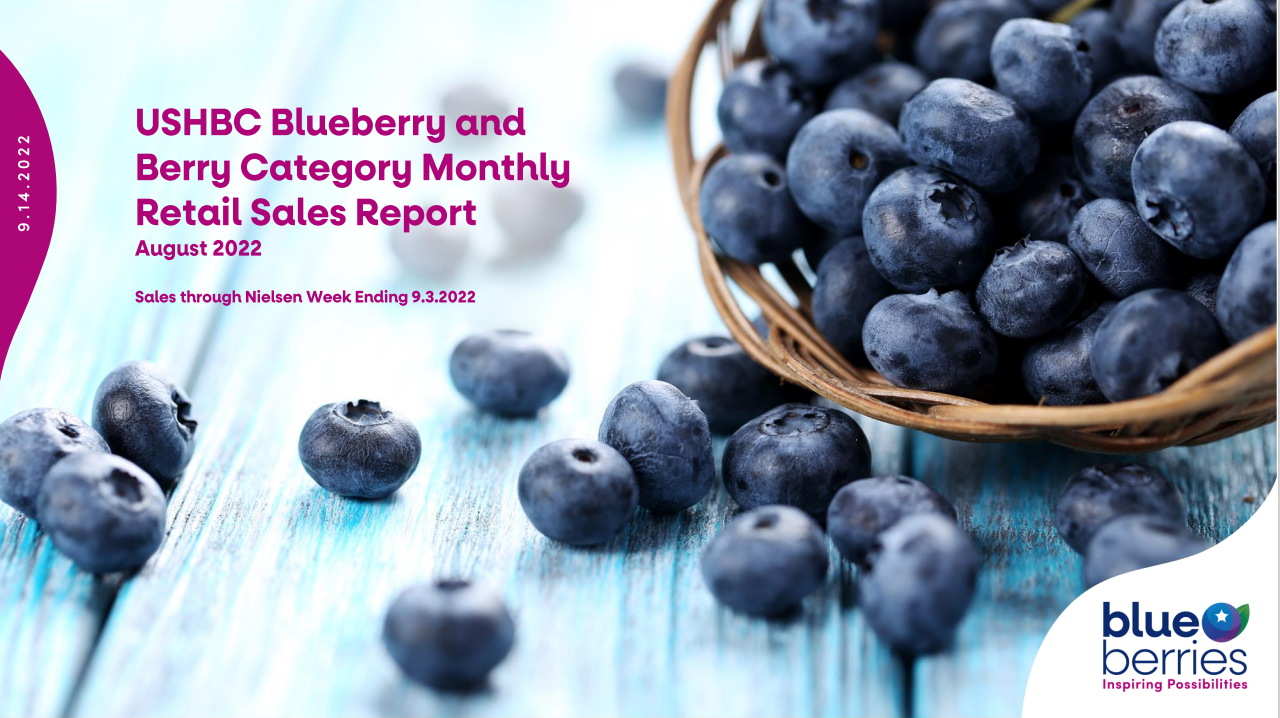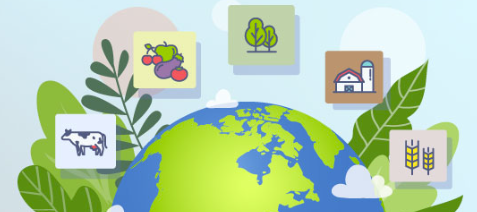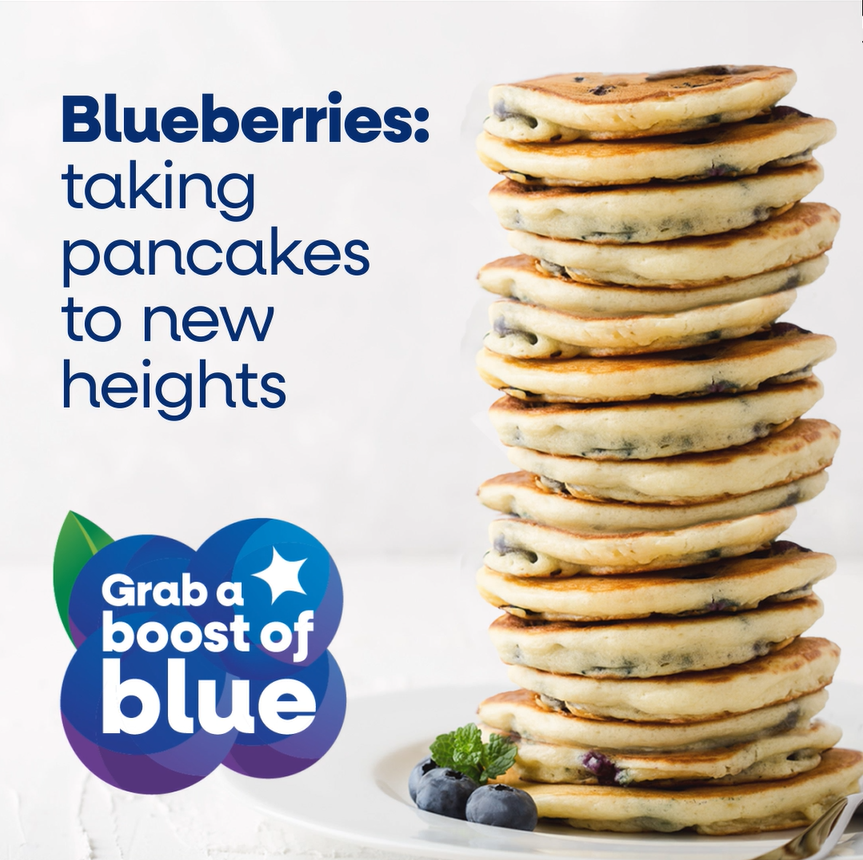Topics in this issue of Behind the Blue:
- August 2022 Nielsen Report Now Available
- Berry Industry Boosted by USDA Climate-Smart Projects
- National Pancake Day Coming Up on September 26
August 2022 Nielsen Report Now Available

The August 2022 Nielsen report shows that total blueberry sales (fresh and frozen combined) are down -1.5% in volume and up +9.9% in dollars vs. 2021.
Total fresh blueberry sales are down -2.4% in volume and up +9.2% in dollars vs year average (YA). The fresh organic segment is flat in volume (+0.2%) and up +11.7% in dollars vs. YA. The fresh conventional segment is down -2.9% in volume and up +8.4% in dollars vs. YA.
The average price per pound for all fresh blueberries at retail in August 2021 was $4.19/lb, which has increased +11.8% to $4.69/lb. Fresh conventional blueberry prices have increased +11.7% from $3.91/lb in August 2021 to $4.36/lb. Fresh organic blueberries’ retail prices have increased by +11.5% from $5.56/lb in July 2021 to $6.20/lb.
The frozen blueberry segment is up +4.2% in volume and up +15.9% in dollars. Increases are driven by the conventional segment; up +10.2% in volume and +27.3% in dollars, while the frozen organic segment is down -21.3% in volume and -15.9% in dollars vs. YA.
In previous years, prices within the frozen segment have remained relatively stable, yet have seen increases in every month of 2022. The average price per pound for all frozen blueberries at retail in August 2021 was $3.35/lb, which has increased +11% to $3.73/lb. Frozen conventional blueberry prices have increased +16% from $3.05/lb in August 2021 to $3.52/lb. Frozen organic blueberries’ retail prices have increased by +7% from $4.61/lb in August 2021 to $4.93/lb.
Find monthly Nielsen retail sales data that measures U.S. consumer blueberry and competitive berry purchases here.

Last week, the U.S. Department of Agriculture (USDA) announced it’s investing up to $2.8 billion under the first funding pool of Partnerships for Climate-Smart Commodities. Fifteen of the 70 selected projects are focused on fruit, vegetables and specialty crops. Climate and sustainability are increasingly important considerations across food supply chains, especially as consumers prioritize environmental impact when making purchasing decisions.
USHBC has been working with growers and industry leaders on our Good Practices and Innovation and Technology Committees to identify projects and information in field technology, regenerative agriculture, sustainable food system practices and food safety that could be helpful to blueberry growers and marketers. USHBC has already initiated a BerrySmart Field initiative that will eventually serve as a platform for sharing sustainability-related information with growers.
What does this mean for the blueberry industry? Here are the key projects to watch:
• A Vibrant Future (funding: $15M): This project will incentivize growers of specialty crops to adopt climate-smart production in order to establish a consumer-driven, climate-smart market for fruits and vegetables grown using climate-smart practices. The International Fresh Produce Association is the lead partner, with several other industry leaders listed as major partners.
• Building Soil, Building Equity: Accelerating a Regenerative Farming Movement in Appalachia and the Southeast (funding: $20M): This project, led by Accelerating Appalachia, seeks to build climate-smart markets and sequester carbon over thousands of acres of Appalachian and rural southeastern land through strategic recruitment from networks of producers. The project will use education, outreach, technical assistance and incentivizing producers to adopt community supported agriculture models.
• Elevated Foods Partnerships for Climate Smart Commodities (funding: $20M): This project, led by Elevated Foods, will implement climate-smart production practices, activities and systems on a large scale across cropland planted to fruits and vegetables, with a particular focus on fresh fruit and vegetable crops. Partners propose to implement practices on hundreds of thousands of acres planted to fruit and vegetables in key growing regions across the U.S., and extend the producer reach to urban farmers in Orange County, California, and the Navajo Nation to meet the needs of small and historically underserved producers.
These projects will provide technical and financial assistance to producers to implement climate-smart production practices, pilot innovative and cost-effective methods for monitoring and reporting of greenhouse gas benefits, develop markets and promote the resulting climate-smart commodities. Anticipated results include expanded markets and revenue streams, broad industry engagement and more than 50 million metric tons of carbon dioxide equivalent sequestered. View the full list of selected projects with additional details here.
National Pancake Day Coming Up on September 26

Mark your calendar for Monday, September 26 to engage with customers and blueberry fans on National Pancake Day!
Turnkey content from National Blueberry Pancake Day is available to use on social media and other communications channels. Don’t forget to share your favorite recipe for a sweet boost of blue!
National Blueberry Pancake Day is just one of the many moments in our promotional calendar that inspires consumers to Grab a Boost of Blue. In addition to these fun food holidays for consumers, our year-round marketing plan is packed with “power periods” for building upon key buying periods and seasonal trends.
To access this asset and take a look at what else is coming up, visit our Grab of Boost of Blue Industry Resources page.
